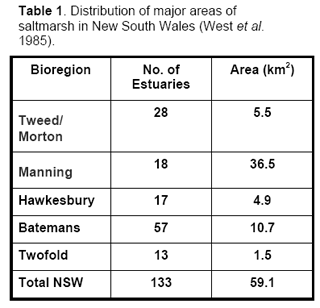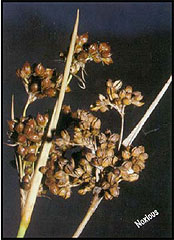WHERE ARE SALTMARSHES FOUND?
Saltmarshes can be found in estuaries along the whole New South Wales coastline, with the largest area occurring in the Manning Bioregion (Table 1 and Figure 6). WHY IS SALTMARSH SO IMPORTANT TO FISH?
Saltmarsh is important to fish species by providing a source of food and by providing habitat and shelter when the saltmarsh is inundated at high tide. Studies by Thomas and Connolly (2001) found that up to 41 species of fish can inhabit tidal saltmarsh areas. These included commercial species such as yellowfin bream, sand whiting, various mullets and snub nosed garfish. The most common fish were small species such as perchlets and gobies, which are important in the estuarine food chain as a source of food for larger fish and for birds. Saltmarsh vegetation provides basic inputs of carbon to estuaries primarily in the form of dead leaves and branches. The carbon material becomes part of the food chain when it is colonised by bacteria and fungi which converts the carbon into more easily digestible carbohydrates and proteins. Tidal currentsdisperse this material which can then be taken up by filter feeders such as mussels or oysters and surface feeders such as crabs and mullet (Valiela et al. 1978).
Saltmarsh supports a variety of invertebrates, including crabs, prawns, molluscs and insects. The invertebrates are preyed upon by fish during high tides. For example, yellowfin bream feed on crabs and prawns while small fish such as gobies feed on mosquito larvae (Williams, 2001). • changes in tidal regimes or sea level • changes to catchments from urban activities resulting in altered sediment and nutrient inputs and land subsidence. Saltmarsh also provides habitat for many migratory bird species, such as the Sharp-Tailed Sandpiper (Calidris acuminate) (Smith, 1991).
STATUS OF SALTMARSH IN NSW
Many areas of saltmarsh, particularly those near urban centres, have been lost or become degraded as a result of drainage (floodgates), unrestricted stock access, weed invasion, dumping, stormwater runoff and damage from motor vehicles. Significant losses have also occurred as a result of reclamation and drainage activities (Adam et al. 1988: Zann, 1995 & 1996).
Where saltmarsh is restricted along its landward edge by urban development or elevated topography, it can be squeezed against these obstacles by landward-shifting mangroves, and over time, will be replaced by them (Saintilan and Williams, 1999).
Within NSW, saltmarsh area is contracting. A study by Wilton (2002) of mangrove and saltmarsh dynamics in nine estuaries in NSW showed that saltmarsh loss ranged from 12% to 97%, largely due to landward mangrove incursion into saltmarsh habitats.
Williams and Watford (1997) found that within Berowra and Marramarra Creeks, tributaries of the Hawkesbury River, the area of saltmarsh had decreased by 38% between 1941 and 1992. In the Hunter River, the area of saltmarsh has fallen by approximately 52% from 2133ha in 1954 to 1112ha in 1994 (Figure 7) (Williams et al. 2000).
Saintilan and Williams (1999) concluded that there are number of factors contributing to the landward incursion by mangroves into saltmarsh such as:
- changing patterns in annual rainfall
- changes in, or cessation of, agricultural activities
- changes in tidal regimes or sea level
- changes to catchments from urban activities resulting in altered sediment and nutrient inputs and land subsidence.
However, they also found that there was little consistency between the estuaries in the pattern of contributing factors. |



|
BIBLIOGRAPHY AND FURTHER READING
Adam, P. (1990). Saltmarsh Ecology. Cambridge University Press, Cambridge.
Adam, P., Wilson, N.C. and Huntley, B. (1988). The phytosociology of coastal saltmarsh vegetation in New South Wales. Wetlands (Australia) 7(2): 35-85.
Copeland, C. (1992). Estuarine Fisheries Habitat - A review of their utilisation and importance. Fisheries Bulletin, NSW Department of Primary Industries, Cronulla.
Edgar, G. J. (2000). Australian Marine Life, The plants and animals of temperate waters. Revised edition. Reed New Holland, Australia.
Kailola, P. J., Williams, M. J., Stewart, P. C., Reichelt, R. E., McNee, A. and Grieve, C. (1993). Australian Fisheries Resources. Bureau of Resource Sciences, Department of Primary Industries and Energy, and the Fisheries Research and Development Corporation, Canberra.
Morrisey, D. (1995). Saltmarshes. Ch. 13 In: Underwood, A.J. and Chapman, M.G. (eds) Coastal Marine Ecology of Temperate Australia. UNSW Press pp. 205-220.
Morrison (2001). Historical changes in land cover and predicted distribution of mangrove and saltmarsh in Hexham Swamp. Unpublished Honours Thesis. Newcastle University.
Saintilan, N. and Williams, R.J. (1999). Mangrove transgression into saltmarsh in south-east Australia. Global Ecology and Biogeography Letters, 8: 117-124.
Sainty, G. R. and Jacobs, S. W. L. (1997). Hawkesbury-Nepean Saltmarsh Assessment. Hawkesbury-Nepean Catchment Management Trust, Sydney.
Smith, P. (1991). The Biology and Management of Waders (Suborder Charadrii) in NSW. NSW National Parks and Wildlife Service, Hurstville.
Thomas, B.E. and Connolly, R.M. (2001). Fish use of subtropical saltmarshes in Queensland, Australia: relationships with vegetation, water depth and distance onto the saltmarsh. Marine Ecology Progress. Series. 209:275-288
Valiela, I. Teal, J. M., Volkmann, S., Shafer, D. and Carpenter, E. J. (1978). Nutrient and particulate fluxes in a salt marsh ecosystem: Tidal exchanges and inputs by precipitation and groundwater. Limnology Oceanography. 23 (4), 798-812.
West, R. J., Thorogood, C., Walford, T. and Williams, R. J. (1985). An estuarine inventory for New South Wales, Australia. Fisheries Bulletin 2, Dept. Agriculture, NSW, Australia. 140p.
Williams, R. (2001). 2001 Saltmarsh report. In: Status of Fisheries Resources 2000/2001, Kennelly, S and McVea, T (eds). NSW Department of Primary Industries, Cronulla. pp. 31-35
Williams, R. J. and Watford, F. A. (1997). Change in the Distribution of Mangrove and Saltmarsh in Berowra and Marramarra Creeks, 1941 – 1992. NSW Department of Primary Industries, Fisheries Research Institute, Cronulla. 21pp.
|

